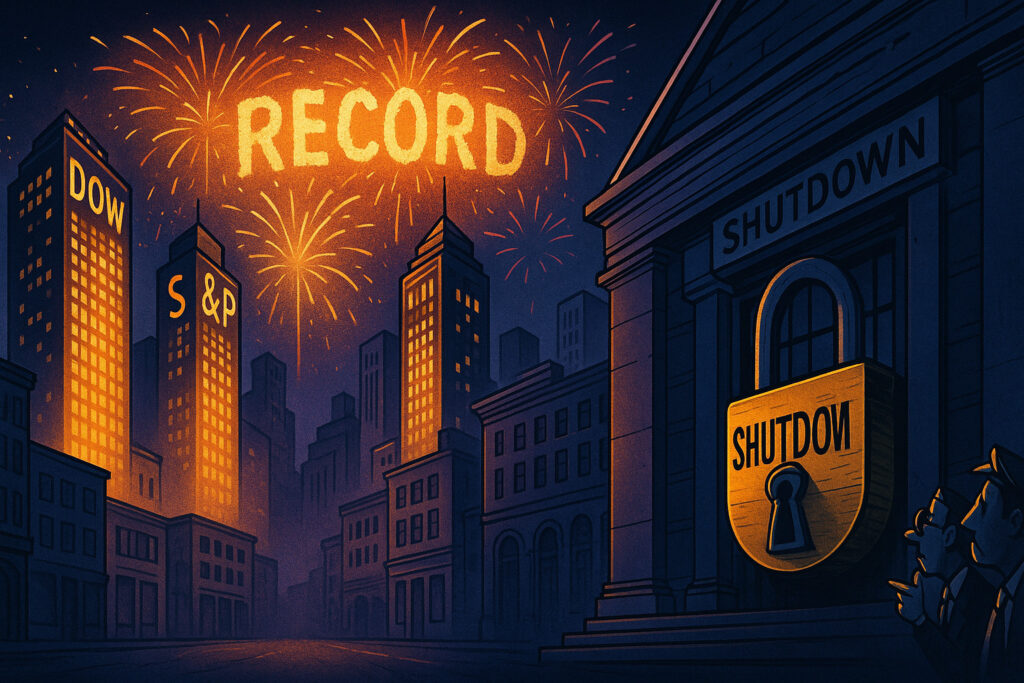Introduction
On 1 October 2025, the markets resisted the worst of the risk signals and pressed higher—even under the shadow of a newly instituted U.S. government shutdown. The S&P 500 rose about 0.3 %, closing at a fresh all-time high around 6,711.20, while the Nasdaq Composite climbed 0.4 % to 22,755.16, and the Dow Jones added 0.1 % to reach 46,441.10. Despite weaker private sector job data and uncertainty over fiscal operations, investors pushed forward, betting that policy clarity would eventually return.
At the same time, gold surged to new highs, Treasury yields fell, and credit default swap spreads on U.S. sovereign debt widened modestly—signs that while the rally is intact, tension is rising in adjacent markets. This was a day when optimism overcame ambiguity, but under a roof that might not hold.
Body
A Brave Rally in Adverse Conditions
Markets opened with caution, weighed by headlines of the government shutdown. Still, buying pressure emerged in tech, pharmaceuticals, and momentum names. The rally was broad: all 11 sectors in the S&P ended in the green. Market breadth confirmed that this was not a narrow squeeze but a deliberate advance.
Investors seemed to treat the shutdown as transitory—an uncertainty to be managed, not an insurmountable wall. Their confidence derived from expectations that the shutdown would be short, or that monetary policy easing would offset its drag.
Private Payroll Report Sinks Confidence—but Only Slightly
The ADP private payroll report came in surprisingly weak, showing a loss of 32,000 jobs in September. This was the sharpest monthly decline in over two years, well below expectations. The report dampened confidence among risk managers, strengthening the narrative that labor momentum is softening.
The weak reading helped undercut expectations that the Fed could afford aggressive easing—yet paradoxically, it also gave bulls another rationale: the case for a more dovish stance just got stronger. Markets largely interpreted it as further justification for rate cuts.
Yields Slip as Risk Appetite Returns
Treasury yields responded to the weak jobs data and safe-haven demand. The 10-year yield drifted downward, and the curve steepened slightly, alleviating some inversion pressure. This move gave breathing room for long-duration equities and growth names.
But yield relief was tentative. Bond markets remained on guard—each drop in yields was met with scrutiny, as traders debated whether weaker data would justify a more aggressive Fed pivot or intensify inflation fears later.
Gold Breaks Out, CDS Spreads Tighten
In risk-off undercurrents, gold surged to new record highs, drawing inflows from institutional players seeking insurance. Its rise was a clear signal that many portfolio managers are hedging against volatility or policy missteps.
At the same time, credit default swap (CDS) spreads on U.S. government debt widened modestly, reflecting increased concern about sovereign risk under a shutdown scenario. Six-month CDS spread rose to ~17 basis points—the highest since mid-July. Longer tenors also ticked up, though not dramatically.
The dual movement—gold up, CDS spreads wider—underscored that risk markets were not wholly complacent even as equity markets pressed higher.
Sector Rotation & Leadership
Technology made a strong showing, buoyed by strength in software, cloud, and semiconductor names. The recovery in tech validated that the sector remains central to equity leadership.
Pharmaceuticals and life sciences names rallied notably. Investors reacted to announcements around drug policy and a direct-to-consumer drug distribution initiative that boosted forward earnings and regulatory expectations in the healthcare space.
Cyclicals like industrial and materials joined the advance, supported by the yield relief and revived optimism about future investment and infrastructure demand.
Financials were mixed: banks benefited modestly from yield curve steepening, but caution around credit quality and loan demand constrained their upside.
Energy lagged, pressured by weaker demand signals and lower oil futures. Defensive sectors (staples, utilities, healthcare) also saw inflows as investors hedged exposure.
The rotation was evident: bulls were redeploying gains into non-tech names, building a broader base under the rally.
Shutdown Risk & Data Silence
The shutdown took effect at 12:01 a.m. ET. That means critical economic data—nonfarm payrolls, CPI, manufacturing surveys—face suspension or delay. The U.S. Department of Labor already indicated that some reports may be postponed. This raises uncertainty: markets will have to navigate on even thinner real data, relying more heavily on private proxies and company guidance.
In such a vacuum, policy signaling and communication from the Fed gain even more weight. Without fresh data, central bank guidance may drive volatility more sharply.
Additionally, weekly GDP drag estimates surfaced: the White House projected potential $15 billion in GDP loss per week if the shutdown persists. The economic ripple effects—reduced consumer spending, federal worker furloughs—could broaden into surprise macro weakness.
Investors are walking a tightrope: they are betting on the shutdown’s brevity and the Fed’s resolve—but the path is unpredictable.
Conclusion
1 October 2025 reminded markets they can rally despite uncertainty—but only to an extent. The S&P, Nasdaq, and Dow all notched gains in a challenging environment, driven by tech and pharmaceuticals, yield relief, and weak jobs data. Gold surged to records, sovereign risk prices widened, and the shutdown now threatens to mute key forward signals.
This was a day of conviction tempered by reality. The market’s ascent continues, but the margin for misstep is narrowing.
Key Questions Ahead
- Will the Fed lean into easing if September data (once published) remains weak, or signal restraint if inflation surprises?
- How long can equities ascend without reliable data flow to validate fundamentals?
- Will gold and credit spreads remain elevated as off-balance risks build?
- Can sectors beyond tech sustain momentum under macro drag and multiple compression?
- What are the consequences if the shutdown lingers beyond a week—will the “short disruption” narrative hold?
1 October may go down as “Records in the Dark”—markets charting new highs while fiscal signals dim and volatility coils just beneath the surface.
